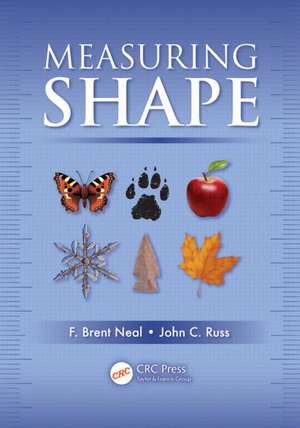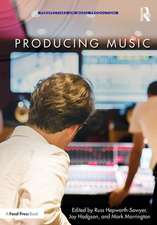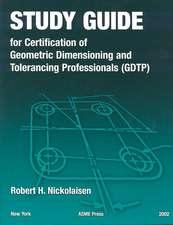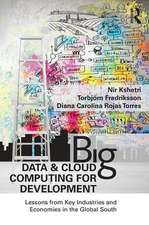Measuring Shape
Autor F. Brent Neal, John C. Russen Limba Engleză Hardback – 5 iun 2012
—Tom Malzbender, Hewlett-Packard Laboratories, Palo Alto, California, USA
Useful for those working in fields including industrial quality control, research, and security applications, Measuring Shape is a handbook for the practical application of shape measurement. Covering a wide range of shape measurements likely to be encountered in the literature and in software packages, this book presents an intentionally diverse set of examples that illustrate and enable readers to compare methods used for measurement and quantitative description of 2D and 3D shapes. It stands apart through its focus on examples and applications, which help readers quickly grasp the usefulness of presented techniques without having to approach them through the underlying mathematics.
An elusive concept, shape is a principal governing factor in determining the behavior of objects and structures. Essential to recognizing and classifying objects, it is the central link in manmade and natural processes. Shape dictates everything from the stiffness of a construction beam, to the ability of a leaf to catch water, to the marketing and packaging of consumer products. This book emphasizes techniques that are quantitative and produce a meaningful yet compact set of numerical values that can be used for statistical analysis, comparison, correlation, classification, and identification.
Written by two renowned authors from both industry and academia, this resource explains why users should select a particular method, rather than simply discussing how to use it. Showcasing each process in a clear, accessible, and well-organized way, they explore why a particular one might be appropriate in a given situation, yet a poor choice in another. Providing extensive examples, plus full mathematical descriptions of the various measurements involved, they detail the advantages and limitations of each method and explain the ways they can be implemented to discover important correlations between shape and object history or behavior. This uncommon assembly of information also includes sets of data on real-world objects that are used to compare the performance and utility of the various presented approaches.
| Toate formatele și edițiile | Preț | Express |
|---|---|---|
| Paperback (1) | 613.49 lei 6-8 săpt. | |
| CRC Press – 29 mar 2017 | 613.49 lei 6-8 săpt. | |
| Hardback (1) | 1401.21 lei 6-8 săpt. | |
| CRC Press – 5 iun 2012 | 1401.21 lei 6-8 săpt. |
Preț: 1401.21 lei
Preț vechi: 1708.80 lei
-18% Nou
Puncte Express: 2102
Preț estimativ în valută:
268.13€ • 280.51$ • 222.73£
268.13€ • 280.51$ • 222.73£
Carte tipărită la comandă
Livrare economică 03-17 aprilie
Preluare comenzi: 021 569.72.76
Specificații
ISBN-13: 9781439855980
ISBN-10: 1439855986
Pagini: 460
Ilustrații: 376
Dimensiuni: 156 x 234 x 28 mm
Greutate: 1.02 kg
Ediția:New.
Editura: CRC Press
Colecția CRC Press
ISBN-10: 1439855986
Pagini: 460
Ilustrații: 376
Dimensiuni: 156 x 234 x 28 mm
Greutate: 1.02 kg
Ediția:New.
Editura: CRC Press
Colecția CRC Press
Cuprins
The Meaning(s) of Shape. The Role(s) of Computers. Two-Dimensional Measurements (Part 1). Two-Dimensional Measurements (Part 2). Three-Dimensional Shapes. Classification, Comparison, and Correlation.
Notă biografică
Brent Neal is a scientist and industrial researcher with Milliken & Company, where he currently leads the central materials characterization and analytical chemistry facility. In this role, he leads efforts in technology and product development through deep understanding of materials performance. He has three patents issued or pending based on his work in polymer-matrix composites. Prior to his tenure at Milliken & Company, he consulted and developed bespoke software for quantitative image analysis. He received his Ph.D. in solid state physics from Louisiana State University in 2002. Over the course of his career, he has measured and analyzed images from many different fields and his experience in materials characterization and measurement has been applied everywhere from the lab bench to manufacturing plants.
In his 50-year career as scientist and educator, John Russ has used image processing and analysis as a principal tool for understanding and characterizing the structure and function of materials. Much of Russ' research work has been concerned with the microstructure and surface topography of metals and ceramics. He has received funding for his research from government agencies and from industry. Teaching the principles and methods involved to several thousand students—in addition to consulting for many industrial clients—has further broadened Dr. Russ’ experience and the scope of applications for image processing and analysis. He continues to write and consult for a variety of companies (and to provide expert testimony in criminal and civil cases). He also still teaches image processing and analysis workshops worldwide and reviews publications and funding proposals.
In his 50-year career as scientist and educator, John Russ has used image processing and analysis as a principal tool for understanding and characterizing the structure and function of materials. Much of Russ' research work has been concerned with the microstructure and surface topography of metals and ceramics. He has received funding for his research from government agencies and from industry. Teaching the principles and methods involved to several thousand students—in addition to consulting for many industrial clients—has further broadened Dr. Russ’ experience and the scope of applications for image processing and analysis. He continues to write and consult for a variety of companies (and to provide expert testimony in criminal and civil cases). He also still teaches image processing and analysis workshops worldwide and reviews publications and funding proposals.
Recenzii
" ... the reader is immediately engaged by this book more than any other I have read on the subject, most of which either scan the subject more superficially, or require considerable statistical or mathematical facility."
— Sky Alibhai, WildTrack, Monchique, Portugal
"As an introduction, it is lively and clearly written…Generates reader interest. … The purpose is to invite and attract the reader to the subject. This is done very well. … Well illustrated…Upgrades methods in older books, e.g., 3-D measurement discussion…This book is a compelling mandate to replace perception-based morphotype constructs in any systematic analysis of morphology."
— Irwin Rovner, Binary Analytical, Raleigh, North Carolina, USA
"John Russ is the master of explaining how image processing gets applied to real-world situations. With Brent Neal, he’s done it again in Measuring Shape, this time explaining an expanded toolbox of techniques that includes useful, state-of-the-art methods that can be applied to the broad problem of understanding, characterizing, and measuring shape. He has a gift of finding the kernel of a particular algorithm, explaining it in simple terms, then giving concrete examples that are easily understood. His perspective comes from solving real-world problems and separating out what works in practice from what is just an abstract curiosity."
—Tom Malzbender, Hewlett-Packard Laboratories, Palo Alto, California, USA
"Extremely readable and engaging, easy to understand… Very complete coverage of methods, with rich examples… Comprehensive references to original publications… most books on digital imaging barely mention a few aspects of the subject [of shape], with few examples. This book provides a very accessible guide to the various approaches that are used, with an engaging style and many examples drawn from a broad spectrum of real objects. While the book includes many mathematical calculations and procedures, it does so without bogging the reader down or hiding the important meaning. It is actually fun to read."
—Louis Ross, University of Missouri (retired), Overland Park, Kansas, USA
— Sky Alibhai, WildTrack, Monchique, Portugal
"As an introduction, it is lively and clearly written…Generates reader interest. … The purpose is to invite and attract the reader to the subject. This is done very well. … Well illustrated…Upgrades methods in older books, e.g., 3-D measurement discussion…This book is a compelling mandate to replace perception-based morphotype constructs in any systematic analysis of morphology."
— Irwin Rovner, Binary Analytical, Raleigh, North Carolina, USA
"John Russ is the master of explaining how image processing gets applied to real-world situations. With Brent Neal, he’s done it again in Measuring Shape, this time explaining an expanded toolbox of techniques that includes useful, state-of-the-art methods that can be applied to the broad problem of understanding, characterizing, and measuring shape. He has a gift of finding the kernel of a particular algorithm, explaining it in simple terms, then giving concrete examples that are easily understood. His perspective comes from solving real-world problems and separating out what works in practice from what is just an abstract curiosity."
—Tom Malzbender, Hewlett-Packard Laboratories, Palo Alto, California, USA
"Extremely readable and engaging, easy to understand… Very complete coverage of methods, with rich examples… Comprehensive references to original publications… most books on digital imaging barely mention a few aspects of the subject [of shape], with few examples. This book provides a very accessible guide to the various approaches that are used, with an engaging style and many examples drawn from a broad spectrum of real objects. While the book includes many mathematical calculations and procedures, it does so without bogging the reader down or hiding the important meaning. It is actually fun to read."
—Louis Ross, University of Missouri (retired), Overland Park, Kansas, USA
Descriere
Clear, accessible, and well-organized, this book provides a one-stop resource on the various techniques of 2- and 3D shape description and measurement. It presents consistent and coherent summaries of the various methods so that engineers, researchers, and others can compare methods, select the one appropriate for their specific task, and gain enough detailed information about them to implement and test them. It includes practical application such as relating fractal dimension of nuclear membranes in cells to disease, or relating harmonic analysis to weathering of sediments, or classifying the genetics of squash seeds by dimensionless ratios.











